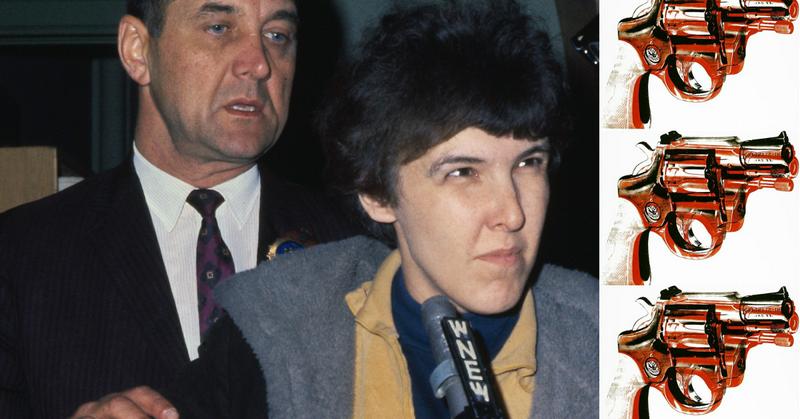Who Shot (And Technically Killed) Andy Warhol -- And Why? Story Of An Art Assassin
By | June 2, 2020

In 1968, Pop artist Andy Warhol was shot by Valerie Solanas, a peripheral figure in the New York art world. Two bullets from Solanas' .32 Beretta ripped through Warhol's stomach, liver, spleen, and lungs. Doctors barely saved his life -- in fact, he died, briefly, but was revived -- and the experience had a lasting effect on his art. Who was Valerie Solanas, the person who took it upon herself to kill the world's most famous artist?
The Forces That Created Her

Valerie Solanas was born in in 1936 New Jersey and had claimed that her father sexually abused her. After her parents divorced, she did not get along with her stepfather and began rebelling. In 1949, her mother sent her to live with her grandparents. According to Solanas, her grandfather was a violent alcoholic who beat her. At 15, she left her grandparents and became homeless. By 1953, she gave birth to a son, whose father was a married sailor. She did, however, graduate from high school and attend the University of Maryland, where she majored in Psychology. While there, she hosted a radio show where she gave advice on combatting men. After graduating, she attended the University of Minnesota, pursuing a graduate degree in psychology. After she dropped out, she attended Berkeley for a few classes and began working on the SCUM Manifesto.
Her Anger Manifests In Her Writing

By the mid 1960s, she had moved to New York City and supported herself by prostitution and panhandling. She also continued working on The SCUM Manifesto which she self-published in 1967 and sold about 400 copies on the streets of Greenwich Village. Before publishing with Olympia Press in 1968, Soldanas had signed a contract with Maurice Girodias for a novel, but she convinced him to accept the Manifesto in its place. The SCUM Manifesto begins “Life in this society being, at best, an utter bore and no aspect of society being at all relevant to women, there remains to civic-minded, thrill-seeking females only to overthrow the government, eliminate the money system, institute complete automation, and destroy the male sex.”
Her First Meeting With Warhol

In 1967, she met Andy Warhol outside The Factory and tried to convince him to read a handwritten script of a play that she had written, Up Your Ass. He found the play to be offensive and was worried that it was a police trap, but as the play was handwritten, he apparently responded to her by offering her a job as a typist. He kept the copy, and when Solanas contacted Warhol about the play, she was told he had lost it and she then demanded he pay for the lost manuscript. He offered her $25 to play a role in his film I, a Man. She also had a nonspeaking role in Bikeboy. She continued to call Warhol to get her play back, convinced that Warhol was going to steal her ideas. He allegedly had appropriated parts of their conversations for some of his work.
The Day She Shot Warhol

Accounts vary as to the events of the day she shot Andy Warhol. The likely story was that she first went to the Actor’s Studio, looking for Lee Strasburg. She left a copy of her play for Strasburg as he was not there. She then went to Margo Feiden to try to convince her to produce the play. After she spoke to Felden for nearly four hours about producing the play and a world without men, she told Feiden that “you will produce the play because I'll shoot Andy Warhol and that will make me famous and the play famous, and then you'll produce it." Feiden called the police after Solanas left, but to no avail.
Solanas arrived at The Factory and waited for Warhol to arrive. Morrissey tried to get rid of her, but she continued to wait. When he did arrive, the phone rang and Warhol answered it while Morrissey was in the bathroom. At that point, she shot Warhol. She also shot Mario Amaya in the hip.
Long Term Effects Of The Shooting

Warhol was declared dead, but doctors revived him. He had permanent damage however, as two bullets hit his stomach, liver, spleen, esophagus, and both lungs. He was in the hospital for two months recovering from surgeries and would have to wear a surgical corset to keep his organs in place for the remainder of his life. The shooting changed his life in other ways as well. He abandoned much of his filmmaking and moved away from his more controversial art. Instead, he invested more energy into business and the founding of the magazine that would become Interview. His artwork also shifted to a theme of death.
The shooting also led to a fear of hospitals, which led to an interest in alternative medicine, such as healing crystals. He postponed gall bladder surgery for several years because of his fears. After he eventually had the surgery, he died from a heart attack, which he might have avoided, if he had the surgery earlier.
The Aftermath For Solanas

After the shooting, Solanas turned herself in that same day, stating that Warhol had “too much control in my life.” The next day, the headline for the New York Daily News read “Actress Shoots Andy Warhol.” She reportedly demanded a retraction because she was a writer, not an actress. After her arrest, she underwent psychiatric evaluations and was diagnosed as a paranoid schizophrenic. However, she was found competent to stand trial. She pled guilty, was sentenced to three years and was released in 1971. She spent the last years of her life in a single occupancy welfare hotel in San Francisco. In her later years, she became increasingly unstable and paranoid until she died in 1988.
